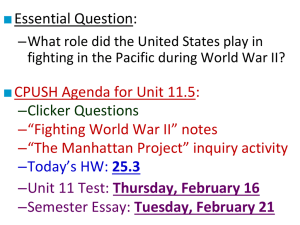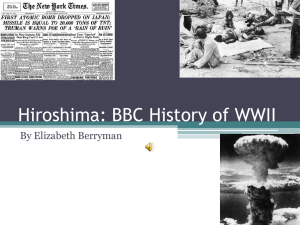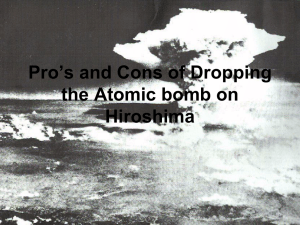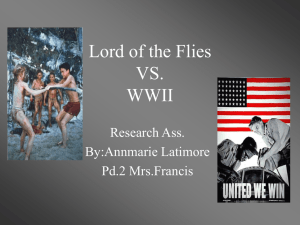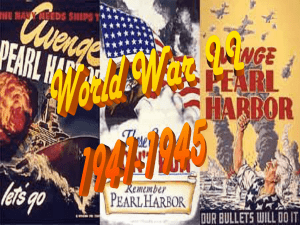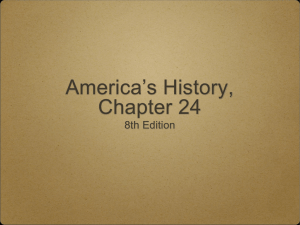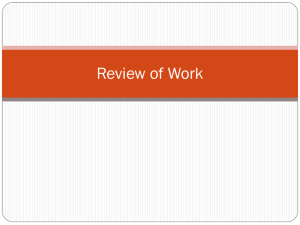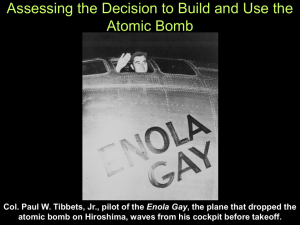Atomic Bomb Power Point
advertisement
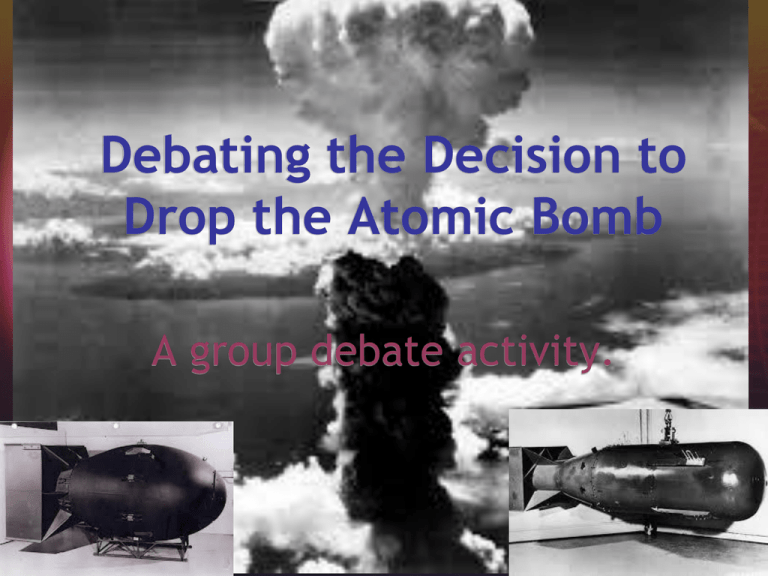
Debating the Decision to Drop the Atomic Bomb A group debate activity. Essential Questions Unit Focus: When should the United States go to war? Unit Focus: What is required to achieve victory in war? Unit Focus: How did America become a superpower? Activity Focus: Should the United States use the atomic bomb to end World War II? Unit Focus: What is the proper role of the government in people’s lives? Unit Focus: Did America’s involvement in World War II and the Cold War move it closer or further away from its founding ideals? GOAL Can you explain 3 claims for your viewpoint about the atomic bomb? Directions 1. 2. 3. 4. Go over the debate topics. Break into groups. Assign debate topic and point of view. Research the topic and fill in their debate organizer. 5. Create an introductory paragraph that presents a debate thesis and introduces three claims. Topics to Debate Should the United States build an atomic bomb? Should the United States drop an atomic bomb on Japan? Should the United States drop a second bomb on Japan? Did the United States make the correct decision about dropping the bomb? Debate Preparation 1. Class is broken into 2 groups. Pro and anti bomb. 2. Students are assigned a topic to represent. 1. 2. 3. 4. Should the United States build an atomic bomb? Should the United States drop an atomic bomb on Japan? Should the United States drop a second bomb on Japan? Did the United States make the correct decision about dropping the bomb? 3. Read and highlight/underline the handout. 4. In your notebook, write notes about your topic using information from the textbook and handout. 5. Fill out the debate organizer using the textbook, the handout, and extend your research into other sources. 6. Look at rubric to see how the debate is scored. Debate Steps First Speaker, Proposition Team 2 minutes First Speaker, Opposition Team 2 minutes Second Speaker, Proposition Team 2 minutes Second Speaker, Opposition Team 2 minutes Rebuttal Speaker, Opposition Team 1 minute Rebuttal Speaker, Proposition Team 1 minute Opposition Rebuttal Summary speech for your team. Focus on the 2-4 critical claims your team made. Do not start new arguments. Proposition Rebuttal Summarize the entire debate. Answer the critical claims brought up in the Opposition Rebuttal. Do not start new arguments. Debate Terms Claim- The argument you are making. Counterclaim- The argument your opponent is making or the point you are trying to disprove. Point of information- A request by a member of one team to a person who is speaking to give some of her time to the other team to make a comment or ask a question about her speech. Heckling- An interruption of a speaker during her presentation. Points of Information Also known as POI (pronounced “P-O-I”) May be accepted or rejected May not last longer than 15 seconds Accept only 1 point at a time Person making a POI may not Interrupt the speaker’s answer to the point Make a two-part question Ask a follow-up question Heckle Encouraged heckling Applaud teammates and opponents after their speeches Done by: Pounding on a desktop with an open palm Slapping one’s hand 3-4 times When to: Supporting a partner’s particularly clever or winning argument May add a shout of “Hear! Hear!” to the pounding Disagree with an opponent Shout “Shame!” but do not pound on the table Heckle Illegal heckling Disrupting the debate in any other manner than those listed on the slide above May result in losing points for your debate even if you are not currently debating. President Harry Truman Only recently learned the existence of the atomic bomb program Japanese conduct Has been brutal throughout the war. slaughtered civilians, bombed cities, tortured prisoners-often working them to death. May have caused more deaths during the war than the Nazis May have killed over 17 million people. Sneak attack on Pearl Harbor Battles against the Japanese Resulted in horrendous casualties on both sides: Iwo Jima 22,000 Japanese soldiers only about 1000 survived Okinawa 100,000 Japanese soldiers along with about 150,000 civilians only 7000 surrendered; Military situation War has drastically weakened Japan Japanese navy essentially been destroyed. Bombing destroyed many cities, railroads, and factories. Operation Olympic Invasion plan of Japanese homeland Scheduled for November 1st.. Some advise to blockade the islands and continue bombing until surrender. U.S. bombs Japanese cities on a regular basis almost every major Japanese city hit. firebombing of Tokyo in March killed over 100,000 people. U.S. intercepted messages between Japan and Russia Show Japanese want to surrender with conditions U.S. pursued a policy to surrender unconditionally. Russians have promised the U.S. that they will attack Japan on August 15th. Japan’s Supreme War Council Decision-making body, Hopes to achieve one last major victory before it negotiating seriously with the U.S. Ketsugo - military plan use remaining strength to defend their islands and inflict heavy casualties Think U.S. will have to agree to give better surrender terms Stalin favors unconditional surrender Wants to crush Japan completely. Expects the victorious nations to partition and oversee Japan Include a Russian zone of occupation Similar to Germany American public opinion Favors continually bombing Japan 90% of Americans want Japan's unconditional surrender One-third of Americans favor executing the emperor Almost all other Americans want him removed from power after the war Atomic bomb Successful test on an atomic bomb in the New Mexico desert. A single atomic bomb can destroy a whole city Potsdam Declaration July 26th, Truman issued the Postdam Declaration U.S. threatened the Japanese with utter destruction. Japanese could not return their emperor. Interim Committee Recommendation Bomb should be used against Japan as soon as possible against a war plant surrounded by workers' homes, without prior warning. Other options Some military leaders predict 175,000 American casualties if the U.S. invades Kyushu Two other military strategies available: blockade has become extremely effective: Japan can import almost nothing bombing campaign has weakened Japan. report on the effectiveness of conventional bombing concentrate all of its bombing on railroads, bridges, and ferries, Starvation will become widespread throughout the country Truman takes advice of Interim Committee Use of the atomic bomb against a military target, factory surrounded by workers' houses. U.S. planes dropped the bomb on the city of Hiroshima on August 6th, killing about 100,000 people. The Japanese government did not respond. Russians are about to declare war and attack Japanese forces in Manchuria. The U.S. military plans second atomic bomb on another Japanese city. Truman did not interfere with plans for the second bombing U.S. planes dropped the bomb on Nagasaki on August 9th. President Truman ordered the military not to use atomic bombs without his specific authorization. Fighting ends August 14th September 2nd the U.S. accepted the formal surrender of Japan. Historical perspectives on Truman's decision: Truman's decision to drop the atomic bombs on Hiroshima and Nagasaki remains controversial.

